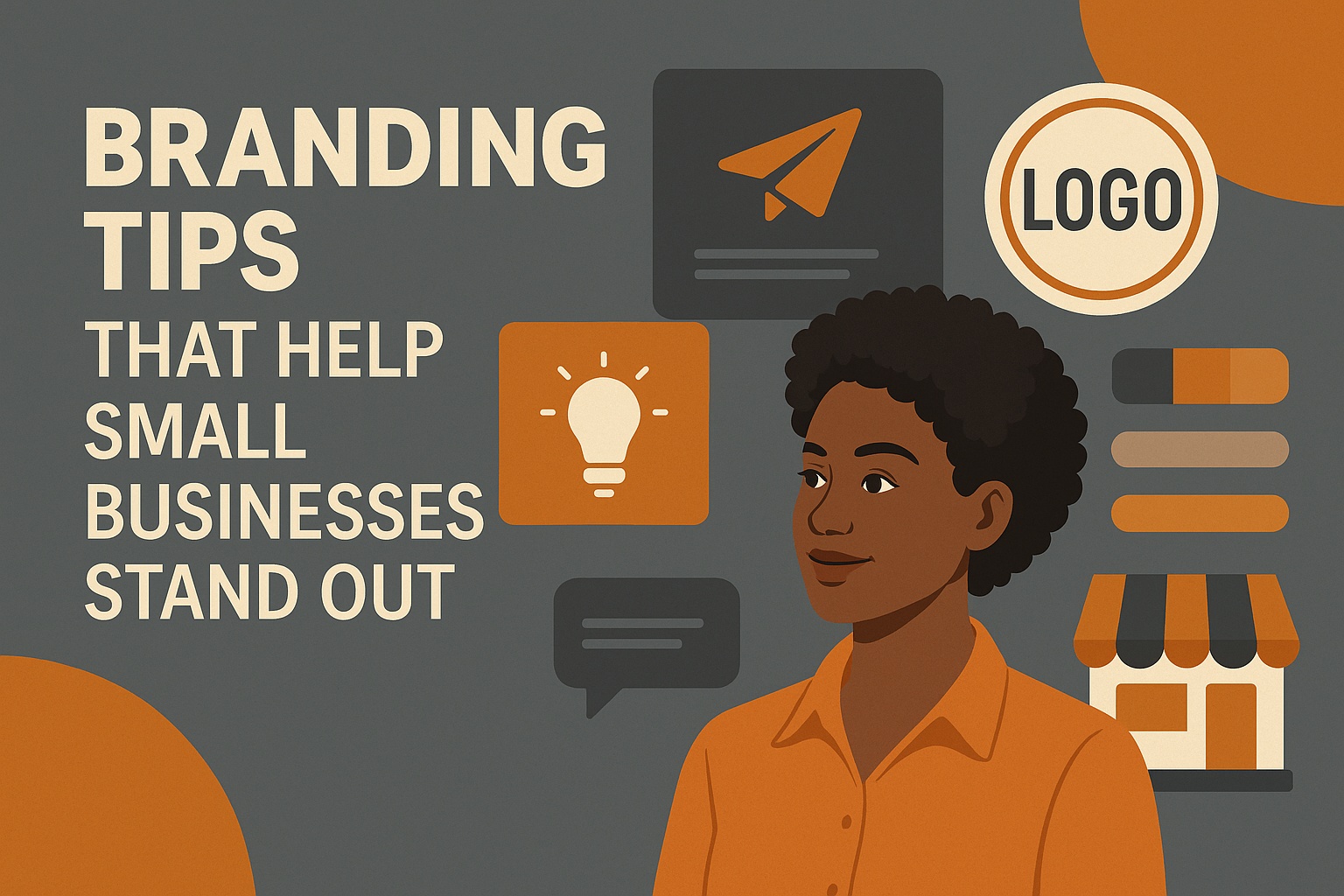Why Branding Matters for Small Businesses
Branding tips.
Branding is the key to standing out in a crowded market. For small businesses especially, it’s not just about having a pretty logo — it’s about how customers perceive your business at every touchpoint. Studies show that 81% of consumers need to trust a brand before they’ll even consider buying from it. That trust is built through consistency, clarity, and connection.
A memorable brand creates recognition, inspires loyalty, and helps justify premium pricing. For example, Sweet Crumbs, a small bakery in Portland, revamped their brand identity with consistent fonts, custom packaging, and clearer messaging. Within just three months, they saw a 3x increase in foot traffic. That’s the power of branding.
Start With a Clear Brand Mission
Every successful brand begins with a mission — a clear reason for existing beyond just making money. A good brand mission tells customers what you stand for and why they should care. It reflects your values, connects emotionally with your target audience, and gives you a guiding light for every marketing decision.
To create your mission, write a one-to-two-sentence statement that combines your business goals with the value you offer. Place this message visibly on your website, packaging, and social media bios. When your mission is clear, your messaging becomes more focused, which builds trust and recognition faster.
How to Build a Brand Identity from Scratch
Creating a brand identity isn’t just about choosing a logo. It’s about building a visual and emotional experience that people associate with your business. Start by selecting two or three brand colors and a clean, readable font set. Stick with those choices consistently across all platforms — from your website and emails to signage and social media posts.
Platforms like Canva and Looka make it easy for entrepreneurs on a budget to create logos and brand kits. If you’re looking for outside help, affordable branding services for startups like Fiverr Pro or 99designs can give you a head start without breaking the bank.
A consistent visual style across all customer-facing materials shows you’re professional and reliable — even if you’re just starting out.
Nail Down Your Unique Value Proposition (UVP)
Your Unique Value Proposition (UVP) explains why a customer should choose your business over others. It’s the foundation of your brand messaging. Think about what you do better than competitors and why that matters to your audience.
A good UVP is clear, benefit-driven, and easy to understand at a glance. It should appear in your social bios, website homepage, and marketing ads. Try testing different versions of your UVP to see what resonates best. For example, a coffee shop might say, “Our coffee doesn’t just taste better — it’s delivered in under 5 minutes.”
When your UVP is strong, your branding becomes sharper and your messaging easier to remember.
Expert Logo Tips for Small Businesses
Your logo is often the first impression someone will have of your business — so make it count. Simplicity is key. A great logo is scalable, looks good in black and white, and works well at both small and large sizes.
Avoid fonts that are too trendy or hard to read. Instead, opt for something timeless and legible. Use DIY tools like Tailor Brands or work with a freelance designer to create a few professional drafts. If you’re unsure, ask for feedback from trusted customers or industry peers.
Following expert logo tips for small businesses ensures your design communicates professionalism while remaining versatile across all branding channels.
Branding Tip: Choose Brand Colors That Resonate
Color is one of the most emotionally powerful elements of branding. It triggers feelings, shapes perceptions, and influences buying decisions — often without customers realizing it. That’s why your brand colors should align with your mission and values.
For example, blue often conveys trust and professionalism, making it a popular choice for banks and healthcare. Green suggests growth and sustainability, ideal for eco-friendly brands. Red evokes urgency and excitement — great for promotions or food products.
📌 1. Table: Color Psychology for Branding
| Color | Emotion/Association | Best For |
|---|---|---|
| Blue | Trust, Security | Finance, Healthcare, Tech |
| Green | Growth, Nature | Wellness, Environment, Food |
| Red | Excitement, Urgency | Food, Retail, Promotions |
| Yellow | Optimism, Energy | Youth brands, Innovation |
| Black | Sophistication, Luxury | Fashion, High-end Products |
Stick to one dominant brand color and two supporting accents. Use tools like Coolors or Adobe Color to experiment with palettes before finalizing your scheme. Then, apply those colors consistently across your website, social posts, packaging, and signage to boost recognition.
Use Consistent Branding Across All Touchpoints
Customers interact with your brand in many places — your website, social media, emails, business cards, storefront, packaging, and more. If your visuals and messaging change from one place to another, it creates confusion. Consistency tells people that you’re trustworthy and dependable.
Create a simple brand guide to help you stay on track. This should include your logo variations, color codes, font styles, tone of voice, and visual do’s and don’ts. Share it with anyone who creates content for your business — from designers to social media managers.
According to a Lucidpress study, consistent branding across all platforms can increase revenue by up to 23%. That’s a huge return for simply staying on brand.
Develop a Memorable Brand Voice
Your brand voice is how your business “sounds” in writing. It’s the language, tone, and personality you use in your emails, social captions, ads, and blog posts. Whether your tone is friendly, professional, quirky, or bold, it should reflect your values and appeal to your target audience.
For example, a kids’ toy store might use playful, imaginative language, while a tax accountant would lean toward a clear and professional tone. No matter what, aim for consistency. If one blog post sounds casual and another sounds stiff, you risk confusing customers.
Start by creating a brand voice chart with examples of how to write (and how not to). This helps keep everyone on the same page and protects your brand’s personality.
Branding Strategies for Local Businesses
For local businesses, branding isn’t just about your logo or website — it’s also about community connection. Neighborhood shops and services can build brand equity faster when they’re actively involved in local life.
Host or sponsor community events, collaborate with nearby businesses, and engage with local social media influencers. Customize your messaging to highlight your neighborhood pride, and make use of physical branding like window decals, sandwich boards, and locally-inspired packaging.
Also, don’t underestimate the value of your Google Business Profile. Keep it updated, respond to reviews, and add branded photos. These small steps signal professionalism and help attract foot traffic.
📌 2. Table: Local Branding Tactics That Drive Results
| Strategy | Description | Outcome |
|---|---|---|
| Host Local Events | Sponsor or run events tied to community interests | Boosts visibility and word-of-mouth |
| Partner with Nearby Businesses | Cross-promote with complementary local brands | Expands reach to shared audiences |
| Optimize Google Business Profile | Add photos, update hours, respond to reviews | Improves local search presence |
| Custom Neighborhood Branding | Use local slang, icons, or images in packaging | Builds emotional connection |
Boost Brand with Social Proof
Social proof is the psychological phenomenon where people copy the actions of others — especially in uncertain situations. When potential customers see others endorsing your business, they’re far more likely to trust and buy from you.
Encourage satisfied customers to leave reviews on platforms like Google, Yelp, and Facebook. Share testimonials and case studies on your website. Highlight user-generated content — like photos of your products in use — on Instagram and other channels.
Here’s a helpful breakdown:
- Customer reviews: Boost conversions by 58%
- User-generated content: Increases engagement by 28%
- Case studies: Earn 30% more trust from new visitors
Set up an automated email to request feedback after purchase, and always thank customers for their support.
Best Brand Design Tips for Entrepreneurs
Good design tells your story before a single word is read. But it doesn’t have to be fancy — it just has to be intentional. Use whitespace to create breathing room, and avoid clutter that distracts from your message.
Make sure your site and graphics are mobile-friendly. Icons and illustrations can help explain complex ideas fast. Consistency across all visuals — fonts, layouts, and imagery — reinforces trust.
If you don’t have a designer, start with a brand board. This is a single sheet that shows your logo, colors, fonts, and photo examples. It becomes your visual blueprint.
When to Rebrand or Refresh Your Branding
It’s normal for a brand to evolve. But how do you know when it’s time to update your look or messaging? Here are some signs:
- You’ve outgrown your original audience or offerings
- Your visuals feel outdated compared to competitors
- Your brand no longer reflects your values or quality
A full rebrand may involve a new name, logo, and brand voice. A brand refresh could be more subtle — like updating your color palette and tightening your message.
📌 3. Table: Signs You Need a Brand Refresh vs Full Rebrand
| Sign | Refresh Needed? | Full Rebrand Needed? |
|---|---|---|
| Visuals look outdated | ✅ | |
| You’ve changed business focus | ✅ | |
| Messaging lacks clarity | ✅ | |
| You want to appeal to a new audience | ✅ | |
| Customer engagement is dropping | ✅ | ✅ (if persistent) |
Don’t change everything overnight. Roll out updates gradually and communicate clearly with your audience so they come along for the journey.
Key Takeaways
- A strong brand creates trust, drives recognition, and helps small businesses grow.
- Define your brand mission, value proposition, and voice early — and stick with them.
- Use consistent design elements like logo, colors, and fonts across all customer touchpoints.
- Engage your community and customers through authentic branding and social proof.
- Update your brand when your business evolves, but always communicate those changes clearly.
Frequently Asked Questions
What is the most important first step in branding for small businesses?
Define your brand mission and value proposition. Everything else flows from there.
How much should I spend on branding?
Start small. Free tools like Canva can help, and you can scale up with freelancers or agencies as you grow.
Do I need a website for branding?
Yes. A website is your digital storefront. It should reflect your brand visually and verbally.
How long does branding take?
You can build a foundation in a few weeks, but branding is ongoing. Refine as you learn more about your customers.
Can I rebrand without losing customers?
Yes, if you communicate the why and maintain core values. Gradual rollouts help ease transitions.
Conclusion
Branding isn’t just a marketing tactic — it’s the heartbeat of your business. The way you look, sound, and act as a brand shapes how people trust and engage with you. Whether you’re just starting out or need a refresh, these branding tips for small businesses will help you create a presence that’s not only recognizable but unforgettable.
Need expert guidance to take your brand to the next level? Contact us today and let’s bring your vision to life.






